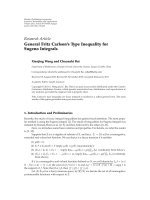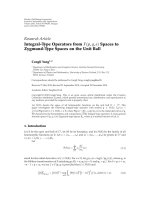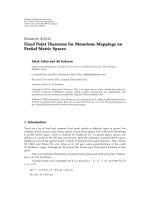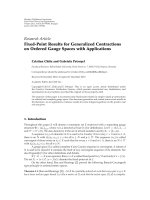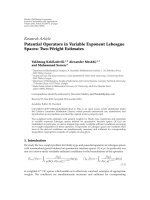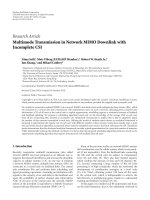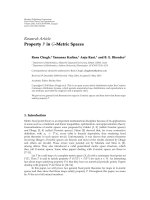báo cáo hóa học:" Research Article Fixed Point in Topological Vector Space-Valued Cone Metric Spaces" pptx
Bạn đang xem bản rút gọn của tài liệu. Xem và tải ngay bản đầy đủ của tài liệu tại đây (479.61 KB, 9 trang )
Hindawi Publishing Corporation
Fixed Point Theory and Applications
Volume 2010, Article ID 604084, 9 pages
doi:10.1155/2010/604084
Research Article
Fixed Point in Topological Vector Space-Valued
Cone Metric Spaces
Akbar Azam,
1
Ismat Beg,
2
and Muhammad Arshad
3
1
Department of Mathematics, COMSATS Institute of Information Technology, Islamabad, Pakistan
2
Department of Mathematics, Centre for Advanced Studies in Mathematics, Lahore University of
Management Sciences, Lahore, Pakistan
3
Department of Mathematics, International Islamic University, Islamabad, Pakistan
Correspondence should be addressed to Ismat Beg,
Received 16 December 2009; Accepted 2 June 2010
Academic Editor: Jerzy Jezierski
Copyright q 2010 Akbar Azam et al. This is an open access article distributed under the Creative
Commons Attribution License, which permits unrestricted use, distribution, and reproduction in
any medium, provided the original work is properly cited.
We obtain common fixed points of a pair of mappings satisfying a generalized contractive type
condition in TVS-valued cone metric spaces. Our results generalize some well-known recent
results in the literature.
1. Introduction and Preliminaries
Many authors 1–16 studied fixed points results of mappings satisfying contractive type
condition in Banach space-valued cone metric spaces. In a recent paper 17 the authors
obtained common fixed points of a pair of mapping satisfying generalized contractive type
conditions without the assumption of normality in a class of topological vector space-valued
cone metric spaces which is bigger than that of studied in 1–16 . In this paper we continue
to study fixed point results in topological vector space valued cone metric spaces.
Let E, τ be always a topological vector space TVS and P asubsetofE. Then, P is
called a cone whenever
i P is closed, nonempty, and P
/
{0},
ii ax by ∈ P for all x, y ∈ P and nonnegative real numbers a, b,
iii P ∩ −P{0}.
For a given cone P ⊆ E, we can define a partial ordering ≤ with respect to P by x ≤ y
if and only if y − x ∈ P. x<ywill stand for x ≤
y and x
/
y, while x y will stand for
y − x ∈ int P, where int P denotes the interior of P.
2 Fixed Point Theory and Applications
Definition 1.1. Let X be a nonempty set. Suppose the mapping d : X × X → E satisfies
d
1
0 ≤ dx, y for all x, y ∈ X and dx, y0 if and only if x y,
d
2
dx, ydy, x for all x, y ∈ X,
d
3
dx, y ≤ dx, zdz, y for all x, y, z ∈ X.
Then d is called a topological vector space-valued cone metric on X,andX, d is called a
topological vector space-valued cone metric space.
If E is a real Banach space then X, d is called Banach space-valued cone metric
space 9.
Definition 1.2. Let X, d be a TVS-valued cone metric space, x ∈ X and {x
n
}
n≥1
a sequence in
X. Then
i {x
n
}
n≥1
converges to x whenever for every c ∈ E with 0 c there is a natural
number N such that dx
n
,x c for all n ≥ N. We denote this by lim
n →∞
x
n
x
or x
n
→ x.
ii {x
n
}
n≥1
is a Cauchy sequence whenever for every c ∈ E with 0 c there is a natural
number N such that dx
n
,x
m
c for all n, m ≥ N.
iiiX, d is a complete cone metric space if every Cauchy sequence is convergent.
Lemma 1.3. Let X, d be a TVS-valued cone metric space, P be a cone. Let {x
n
} be a sequence in
X,and {a
n
} be a sequence in P converging to 0.Ifdx
n
,x
m
≤ a
n
for every n ∈ N with m>n,then
{x
n
} is a Cauchy sequence.
Proof. Fix 0 c take a symmetric neighborhood V of 0 such that c V ⊆ int P. Also, choose
a natural number n
0
such that a
n
∈ V , for all n ≥ n
0
. Then dx
n
,x
m
≤ a
n
c for every
m, n ≥ n
0
. Therefore, {x
n
}
n≥1
is a Cauchy sequence.
Remark 1.4. Let A, B, C, D, E be nonnegative real numbers with A B C D E<1,B C,
or D E. If F A B D1 − C − D
−1
and G A C E1 − B − E
−1
, then FG < 1. In
fact, if B C then
FG
A B D
1 − C − D
·
A C E
1 − B − E
A C D
1 − B − E
·
A B E
1 − C − D
< 1,
1.1
and if D E,
FG
A B D
1 − C − D
·
A C E
1 − B − E
A B E
1 − C − D
·
A C D
1 − B − E
< 1.
1.2
2. Main Results
The following theorem improves/generalizes the results of 5, Theorems 1, 3, and 4 and 4,
Theorems 2.3, 2.6, 2.7, and 2.8.
Fixed Point Theory and Applications 3
Theorem 2.1. Let X, d be a complete topological vector space-valued cone metric space, P be a cone
and m, n be positive integers. If a mapping T : X → X satisfies
d
T
m
x, T
n
y
≤ Ad
x, y
Bd
x, T
m
x
Cd
y, T
n
y
Dd
x, T
n
y
Ed
y, T
m
x
2.1
for all x, y ∈ X,whereA, B, C, D, E are non negative real numbers with ABCDE<1,B C,
or D E. Then T has a unique fixed point.
Proof. For x
0
∈ X and k ≥ 0, define
x
2k1
T
m
x
2k
,
x
2k2
T
n
x
2k1
.
2.2
Then
d
x
2k1
,x
2k2
d
T
m
x
2k
,T
n
x
2k1
≤ Ad
x
2k
,x
2k1
Bd
x
2k
,T
m
x
2k
Cd
x
2k1
,T
n
x
2k1
Dd
x
2k
,T
n
x
2k1
Ed
x
2k1
,T
m
x
2k
≤
A B
d
x
2k
,x
2k1
Cd
x
2k1
,x
2k2
Dd
x
2k
,x
2k2
≤
A B D
d
x
2k
,x
2k1
C D
d
x
2k1
,x
2k2
.
2.3
It implies that
1 − C − D
d
x
2k1
,x
2k2
≤
A B D
d
x
2k
,x
2k1
. 2.4
That is,
d
x
2k1
,x
2k2
≤ Fd
x
2k
,x
2k1
, 2.5
where F A B D/1 − C − D.
Similarly,
d
x
2k2
,x
2k3
d
T
m
x
2k2
,T
n
x
2k1
≤ Ad
x
2k2
,x
2k1
Bd
x
2k2
,T
m
x
2k2
Cd
x
2k1
,T
n
x
2k1
Dd
x
2k2
,T
n
x
2k1
Ed
x
2k1
,T
m
x
2k2
≤ Ad
x
2k2
,x
2k1
Bd
x
2k2
,x
2k3
Cd
x
2k1
,x
2k2
Dd
x
2k2
,x
2k2
Ed
x
2k1
,x
2k3
≤
A C E
d
x
2k1
,x
2k2
B E
d
x
2k2
,x
2k3
,
2.6
4 Fixed Point Theory and Applications
which implies
d
x
2k2
,x
2k3
≤ Gd
x
2k1
,x
2k2
, 2.7
with G A C E/1 − B − E.
Now by induction, we obtain for each k 0, 1, 2,
d
x
2k1
,x
2k2
≤ Fd
x
2k
,x
2k1
≤
FG
d
x
2k−1
,x
2k
≤ F
FG
d
x
2k−2
,x
2k−1
≤···≤F
FG
k
d
x
0
,x
1
,
d
x
2k2
,x
2k3
≤ Gd
x
2k1
,x
2k2
≤···≤
FG
k1
d
x
0
,x
1
.
2.8
By Remark 1.4,forp<qwe have
d
x
2p1
,x
2q1
≤ d
x
2p1
,x
2p2
d
x
2p2
,x
2p3
d
x
2p3
,x
2p4
··· d
x
2q
,x
2q1
≤
⎡
⎣
F
q−1
ip
FG
i
q
ip1
FG
i
⎤
⎦
d
x
0
,x
1
≤
F
FG
p
1 − FG
FG
p1
1 − FG
d
x
0
,x
1
≤
1 F
FG
p
1 − FG
d
x
0
,x
1
.
2.9
In analogous way, we deduced
d
x
2p
,x
2q1
≤
1 F
FG
p
1 − FG
d
x
0
,x
1
,
d
x
2p
,x
2q
≤
1 F
FG
p
1 − FG
d
x
0
,x
1
,
d
x
2p1
,x
2q
≤
1 F
FG
p
1 − FG
d
x
0
,x
1
.
2.10
Hence, for 0 <n<m
d
x
n
,x
m
≤ a
n
, 2.11
where a
n
1 FFG
p
/1 − FGdx
0
,x
1
with p the integer part of n/2.
Fixed Point Theory and Applications 5
Fix 0 c and choose a symmetric neighborhood V of 0 such that c V ⊆ int P. Since
a
n
→ 0 as n →∞,byLemma 1.3, we deduce that {x
n
} is a Cauchy sequence. Since X is a
complete, there exists u ∈ X such that x
n
→ u. Fix 0 c and choose n
0
∈ N be such that
d
u, x
2k
c
3K
,d
x
2k−1
,x
2k
c
3K
,d
u, x
2k−1
c
3K
2.12
for all k ≥ n
0
, where
K max
1 D
1 − B − E
,
A E
1 − B − E
,
C
1 − B − E
. 2.13
Now,
d
u, T
m
u
≤ d
u, x
2k
d
x
2k
,T
m
u
≤ d
u, x
2k
d
T
n
x
2k−1
,T
m
u
≤ d
u, x
2k
Ad
u, x
2k−1
Bd
u, T
m
u
Cd
x
2k−1
,T
n
x
2k−1
Dd
u, T
n
x
2k−1
Ed
x
2k−1
,T
m
u
≤ d
u, x
2k
Ad
u, x
2k−1
Bd
u, T
m
u
Cd
x
2k−1
,x
2k
Dd
u, x
2k
Ed
x
2k−1
,u
Ed
u, T
m
u
≤
1 D
d
u, x
2k
A E
d
u, x
2k−1
Cd
x
2k−1
,x
2k
B E
d
u, T
m
u
.
2.14
So,
d
u, T
m
u
≤ Kd
u, x
2k
Kd
u, x
2k−1
Kd
x
2k−1
,x
2k
c
3
c
3
c
3
c.
2.15
Hence
d
u, T
m
u
c
p
2.16
for every p ∈ N.From
c
p
− d
u, T
m
u
∈ int P
2.17
being P closed, as p →∞, we deduce −du, T
m
u ∈ P and so du, T
m
u0. This implies that
u T
m
u.
6 Fixed Point Theory and Applications
Similarly, by using the inequality,
d
u, T
n
u
≤ d
u, x
2k1
d
x
2k1
,T
n
u
, 2.18
we can show that u T
n
u, which in turn implies that u is a common fixed point of
T
m
,T
n
and, that is,
u T
m
u T
n
u. 2.19
Now using the fact that
d
Tu,u
d
TT
m
u, T
n
u
d
T
m
Tu,T
n
u
≤ Ad
Tu,u
Bd
Tu,T
m
Tu
Cd
u, T
n
u
Dd
Tu,T
n
u
Ed
u, T
m
Tu
≤ Ad
Tu,u
Bd
Tu,Tu
Cd
u, u
Dd
Tu,u
Ed
u, Tu
A D E
d
Tu,u
.
2.20
We obtain u is a fixed point of T. For uniqueness, assume that there exists another point u
∗
in X such that u
∗
Tu
∗
for some u
∗
in X.From
d
u, u
∗
d
T
m
u, T
n
u
∗
≤ Ad
u, u
∗
Bd
u, T
m
u
Cd
u
∗
,T
n
u
∗
Dd
u, T
n
u
∗
Ed
u
∗
,T
m
u
≤ Ad
u, u
∗
Bd
u, u
Cd
u
∗
,u
∗
Dd
u, u
∗
Ed
u, u
∗
≤
A D E
d
u, u
∗
,
2.21
we obtain that u
∗
u.
Huang and Zhang 9 proved Theorem 2.1 by using the following additional
assumptions.
a E Banach Space.
b P is normal i.e., there is a number κ ≥ 1 such that for all x,y,∈ E, 0 ≤ x ≤ y ⇒
x≤κy.
c m n 1.
d One of the following is satisfied:
i B C D E 0withA<1 5, Theorem 1,
ii A D E 0withB C<1/2 5, Theorem 3,
iii A
B C 0withD E<1/2 5, Theorem 4.
Azam and Arshad 4 improved these results of Huang and Zhang 5 by omitting the
assumption b.
Fixed Point Theory and Applications 7
Theorem 2.2. Let X, d be a complete topological vector space-valued cone metric space, P be a cone
and m, n be positive integers. If a mapping T : X → X satisfies:
d
Tx,Ty
≤ Ad
x, y
Bd
x, Tx
Cd
y, Ty
Dd
x, Ty
Ed
y, Tx
2.22
for all x, y ∈ X,whereA, B, C, D, E are non negative real numbers with A B C D E<1.
Then T has a unique fixed point.
Proof. The symmetric property of d and the above inequality imply that
d
Tx,Ty
≤ Ad
x, y
B C
2
d
x, Tx
d
y, Ty
D E
2
d
x, Ty
d
y, Tx
.
2.23
By substituting T
m
T
n
T in the Theorem 2.1, we obtain the required result. Next we
present an example to support Theorem 2.2.
Example 2.3. X 0, 1,Ebe the set of all complex-valued functions on X then E is a vector
space over R under the following operations:
f g
t
f
t
g
t
,
αf
t
αf
t
2.24
for all f,g ∈ E, α ∈ R.Letτ be the topology on E defined by the the family {p
x
: x ∈ X} of
seminorms on E, where
p
x
f
f
x
2.25
then X, τ is a topological vector space which is not normable and is not even metrizable
see 18, 19. Define d : X × X → E as follows:
d
x, y
t
x − y
, 3
x − y
3
t
,
P
{
x ∈ E : x
t
0 ∀t ∈ X
}
.
2.26
Then X, d is a topological vector space-valued cone metric space. Define T : X → X as
Txx
2
/9, then all conditions of Theorem 2.2 are satisfied.
Corollary 2.4. Let X, d be a complete Banach space-valued cone metric space, P be a cone, and m, n
be positive integers. If a mapping T : X → X satisfies
d
T
m
x, T
n
y
≤ Ad
x, y
Bd
x, T
m
x
Cd
y, T
n
y
Dd
x, T
n
y
Ed
y, T
m
x
2.27
for all x, y ∈ X,whereA, B, C, D, E are non negative real numbers with ABCDE<1,B C,
or D E. Then T has a unique fixed point.
Next we present an example to show that corollary 2.4 is a generalization of the results
9, Theorems 1, 3, and 4 and 15, Theorems 2.3, 2.6, 2.7, and 2.8.
8 Fixed Point Theory and Applications
Example 2.5. Let X {1, 2, 3}, B R
2
,andP {x, y ∈B|x, y ≥ 0}⊂R
2
. Define d : X ×X →
R
2
as follows:
d
x, y
⎧
⎪
⎪
⎪
⎪
⎪
⎪
⎪
⎪
⎪
⎪
⎨
⎪
⎪
⎪
⎪
⎪
⎪
⎪
⎪
⎪
⎪
⎩
0, 0
, if x y,
5
7
, 5
, if x
/
y, x, y ∈ X −
{
2
}
,
1, 7
, if x
/
y, x, y ∈ X −
{
3
}
,
4
7
, 4
, if x
/
y, x, y ∈ X −
{
1
}
.
2.28
Define the mapping T : X → X as follows:
T
x
⎧
⎨
⎩
1, if x
/
2,
3, if x 2.
2.29
Note that the assumptions d of results 9, Theorems 1, 3, and 4 and 15, Theorems 2.3, 2.6,
2.7, and 2.8 are not satisfied to find a fixed point of T. In order to apply inequality 2.1
consider mapping T
2
x1 for each x ∈ X, then for A B C D 0,E 5/7,T
2
,andT
satisfy all the conditions of Corollary 2.4 and we obtain T11.
Acknowledgment
The authors are thankful to referee for precise remarks to improve the presentation of the
paper.
References
1 M. Abbas and G. Jungck, “Common fixed point results for noncommuting mappings without
continuity in cone metric spaces,” Journal of Mathematical Analysis and Applications, vol. 341, no. 1,
pp. 416–420, 2008.
2 I. Altun, B. Damjanovi
´
c, and D. Djori
´
c, “Fixed point and common fixed point theorems on ordered
cone metric spaces,” Applied Mathematics Letters, vol. 23, no. 3, pp. 310–316, 2010.
3 M. Arshad, A. Azam, and P. Vetro, “Some common fixed point results in cone metric spaces,” Fixed
Point Theory and Applications, vol. 2009, Article ID 493965, 11 pages, 2009.
4 A. Azam and M. Arshad, “Common fixed points of generalized contractive maps in cone metric
spaces,” Bulletin of the Iranian Mathematical Society, vol. 35, no. 2, pp. 255–264, 2009.
5 A. Azam, M. Arshad, and I. Beg, “Common fixed points of two maps in cone metric spaces,”
Rendiconti del Circolo Matematico di Palermo, vol. 57, no. 3, pp. 433–441, 2008.
6 A. Azam, M. Arshad, and I. Beg, “Banach contraction principle on cone rectangular metric spaces,”
Applicable Analysis and Discrete Mathematics, vol. 3, no. 2, pp. 236–241, 2009.
7 C. C¸ evik and I. Altun, “Vector metric spaces and some properties,” Topological Methods in Nonlinear
Analysis, vol. 34, no. 2, pp. 375–382, 2009.
8 B. S. Choudhury and N. Metiya, “Fixed points of weak contractions in cone metric spaces,” Nonlinear
Analysis: Theory, Methods & Applications, vol. 72, no. 3-4, pp. 1589–1593, 2010.
9 L G. Huang and X. Zhang, “Cone metric spaces and fixed point theorems of contractive mappings,”
Journal of Mathematical Analysis and Applications, vol. 332, no. 2, pp. 1468–1476, 2007.
10 D. Ili
´
candV.Rako
ˇ
cevi
´
c, “Common fixed points for maps on cone metric space,” Journal of
Mathematical Analysis and Applications, vol. 341, no. 2, pp. 876–882, 2008.
Fixed Point Theory and Applications 9
11 S. Jankovi
´
c, Z. Kadelburg, S. Radenovi
´
c, and B. E. Rhoades, “Assad-Kirk-type fixed point theorems
for a pair of nonself mappings on cone metric spaces,” Fixed Point Theory and Applications, vol. 2009,
Article ID 761086, 16 pages, 2009.
12 Z. Kadelburg, S. Radenovi
´
c, and B. Rosi
´
c, “Strict contractive conditions and common fixed point
theorems in cone metric spaces,” Fixed Point Theory and Applications, vol. 2009, Article ID 173838, 14
pages, 2009.
13 P. Raja and S. M. Vaezpour, “Some extensions of Banach’s contraction principle in complete cone
metric spaces,” Fixed Point Theory and Applications, vol. 2008, Article ID 768294, 11 pages, 2008.
14 S. Radenovi
´
c, “Common fixed points under contractive conditions in cone metric spaces,” Computers
& Mathematics with Applications, vol. 58, no. 6, pp. 1273–1278, 2009.
15 Sh. Rezapour and R. Hamlbarani, “Some notes on the paper “Cone metric spaces and fixed point
theorems of contractive mappings”,” Journal of Mathematical Analysis and Applications, vol. 345, no. 2,
pp. 719–724, 2008.
16 P. Vetro, “Common fixed points in cone metric spaces,” Rendiconti del Circolo Matematico di Palermo,
vol. 56, no. 3, pp. 464–468, 2007.
17 I. Beg, A. Azam, and M. Arshad, “Common fixed points for maps on topological vector space valued
cone metric spaces,” International Journal of Mathematics and Mathematical Sciences, vol. 2009, Article ID
560264, 8 pages, 2009.
18 W. Rudin, Functional Analysis, Higher Mathematic, McGraw-Hill, New York, NY, USA, 1973.
19 H. H. Schaefer, Topological Vector Spaces, vol. 3 of Graduate Texts in Mathematics, Springer, New York,
NY, USA, 3rd edition, 1971.


